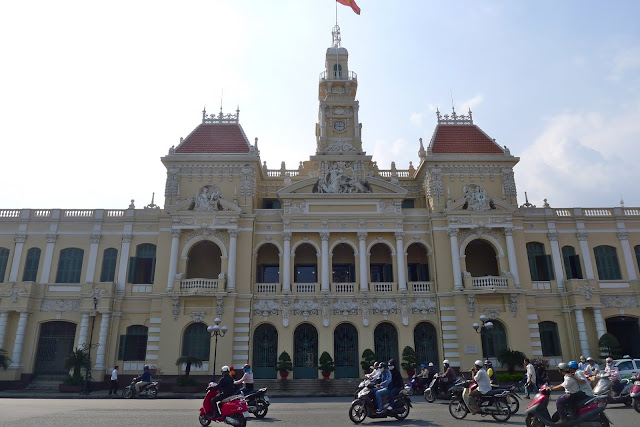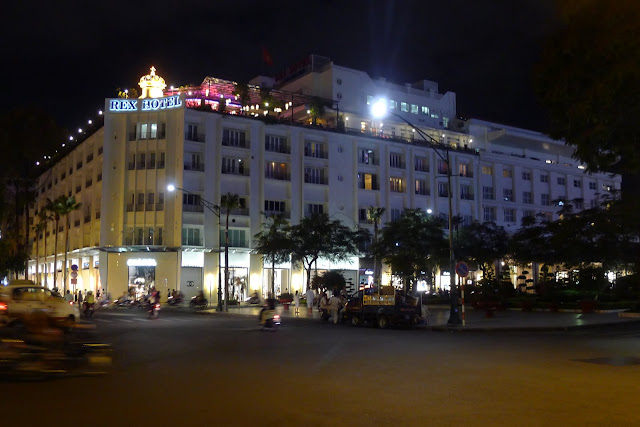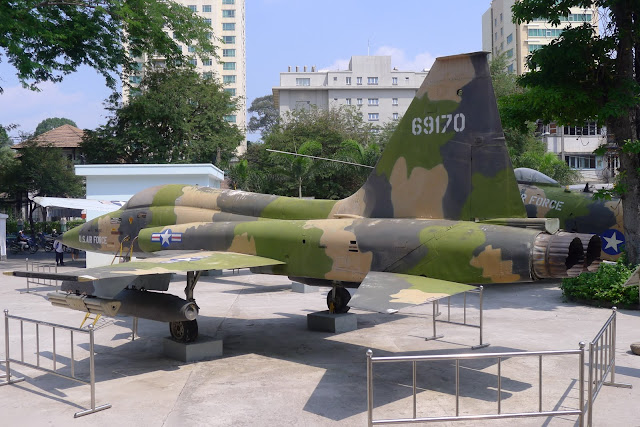I am going to refer to Ho Chi Minh city as Saigon (as you probably know it). The name was changed in 1975 when the communists took over all of South Vietnam. With a population of 5.3 million, it is the economic capital in the far south.
Like Hanoi, traffic is also hectic here as well.
One major difference is on several busy streets, the road is divided and the motorcycles have their own lanes in which to drive.
Vietnam is currently experiencing an unprecedented economic boom. Economic reforms in 1986 permitted the setting up of free market enterprises and also abolished collectivized farming.
Upscale restaurants, hotels, sophisticated shops, cafes, and bars are opening every day.
Saigon is home to many historical buildings and museums which attract many tourists. The city was once known as the "Paris of the Orient."
The Rex Hotel is one of the best known landmarks of Saigon so naturally we booked our rooms there. It was a popular base for journalists during the Vietnam War.
The rooftop bar is a famous spot for social gatherings and its on the list of the book, "1,000 Places to See Before You Die."
It was from this lobby that the U.S. military officials gave their daily press briefings.
The rooftop bar turns into a breakfast restaurant in the morning.
They go overboard to provide every kind of food you can imagine.
After a scrumptious breakfast, we hit the tourist trail. First stop was the Reunification Hall. Built in 1966, this famous building was the former residence of the French governor-general. It was later occupied by South Vietnam President Ngo Dinh.
On April 30,1975, the palace gates were knocked down by a North Vietnam tank. This photograph has become emblematic of the reunification of Vietnam.
If you can remember, it was from this rooftop that American helicopter evacuated the last lucky civilians and government officials of Saigon to aircraft carriers in the Gulf of Tonkin.
Notre Dame Cathedral is the largest church built in the French Empire. When it was completed in 1880, its 120 ft. spires made it the tallest structure in the city. The statue of the Virgin Mary (made in Rome) was brought to Saigon in 1959 in the hope that she would bring peace to the war-torn city.
The Municipal Theater, also known as the Opera House in colonial times, was once the heart of French high society. Built in 1899, it is a fine setting for performances that include everything from traditional Vietnamese theater and western classical music to rock concerts.
The General Post Office is one of the most attractive buildings in the city.
The interior is vaulted and the floor tile is intricate. Wrought iron pillars painted green support the ceiling.
It took 5 years to build (1886 - 1891).
A large portrait of our boy, Ho Chi Minh, gazes over the daily bustle of this busy post office.
The Vinh Nghiem Pagoda is the largest pagoda in the city. It has an 8-story tower that was completed with aid from the Japan-Vietnam Friendship Association in 1971.
The main building with 5 massive lacquered doors lead to ..........
the vast main room where a seated Buddha is flanked by disciples on the main alter.
The War Remnants Museum is located in the former U.S. Information Service building. The documents displayed here document atrocities committed by Americans, Chinese and French soldiers.
In my opinion, we should have listened to them.
On the grounds of the museum, are displayed captured military equipment left by the American Army and Air Force.
Peoples Committee Building was completed in 1908 and it is probably the most photographed building in Saigon. It is the house of the city government. Modeled on the Paris City Hall, it is not open to the public.
We saw very little graffiti in Vietnam. The penalty must be harsh like in Singapore.
Spread out over two floors, the museum represents 300 years of the city's history.
The spacious halls with high ceilings and chandeliers are a much sought-after venue for wedding photographs.
The second floor is devoted to Vietnam's struggle against imperialism.
This is one of the famous bicycles that carried supplies on the famous Ho Chi Minh Trail.
Many engines of war are on display here.
F-5 fighter.
Antiaircraft gun.
 |
| After a long day of sightseeing, we were ready for a cold drink and a nice meal. The Vietnam House, just several blocks from our hotel, was an excellent restaurant. |
This restaurant was famous because it has served many heads of state, including President George Bush.




















































No comments:
Post a Comment